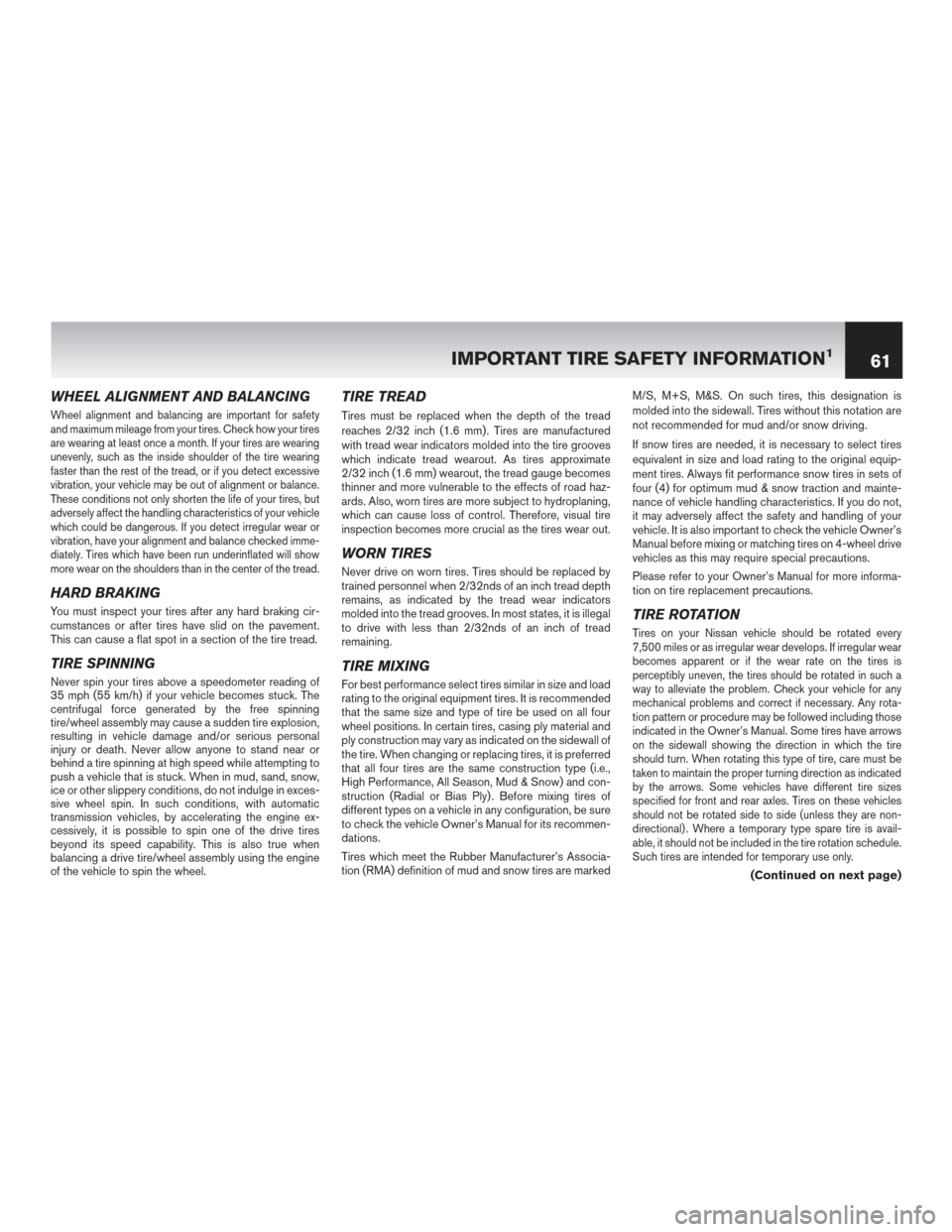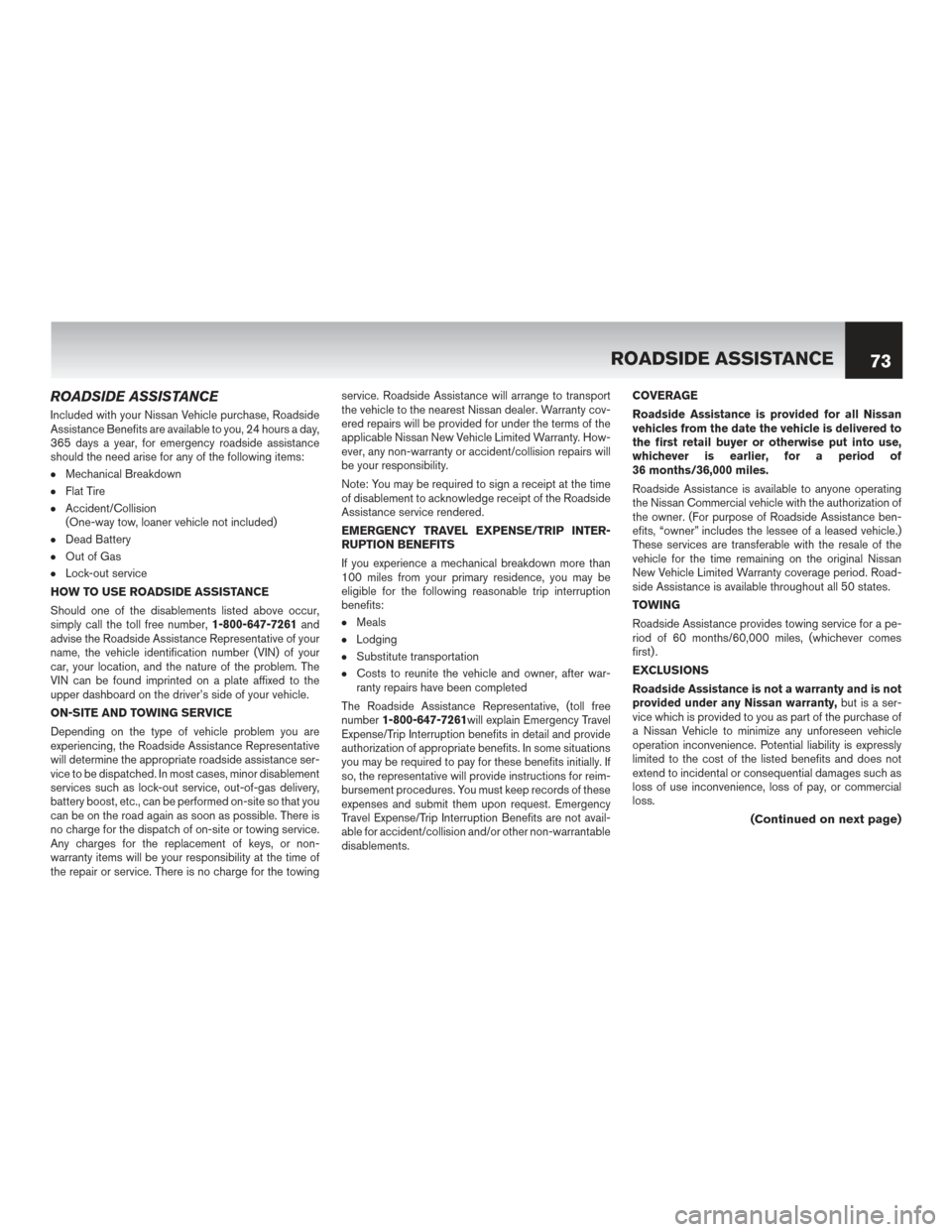2017 NISSAN GT-R tire type
[x] Cancel search: tire typePage 66 of 82

WHEEL ALIGNMENT AND BALANCING
Wheel alignment and balancing are important for safety
and maximum mileage from your tires. Check how your tires
are wearing at least once a month. If your tires are wearing
unevenly, such as the inside shoulder of the tire wearing
faster than the rest of the tread, or if you detect excessive
vibration, your vehicle may be out of alignment or balance.
These conditions not only shorten the life of your tires, but
adversely affect the handling characteristics of your vehicle
which could be dangerous. If you detect irregular wear or
vibration, have your alignment and balance checked imme-
diately. Tires which have been run underinflated will show
more wear on the shoulders than in the center of the tread.
HARD BRAKING
You must inspect your tires after any hard braking cir-
cumstances or after tires have slid on the pavement.
This can cause a flat spot in a section of the tire tread.
TIRE SPINNING
Never spin your tires above a speedometer reading of
35 mph (55 km/h) if your vehicle becomes stuck. The
centrifugal force generated by the free spinning
tire/wheel assembly may cause a sudden tire explosion,
resulting in vehicle damage and/or serious personal
injury or death. Never allow anyone to stand near or
behind a tire spinning at high speed while attempting to
push a vehicle that is stuck. When in mud, sand, snow,
ice or other slippery conditions, do not indulge in exces-
sive wheel spin. In such conditions, with automatic
transmission vehicles, by accelerating the engine ex-
cessively, it is possible to spin one of the drive tires
beyond its speed capability. This is also true when
balancing a drive tire/wheel assembly using the engine
of the vehicle to spin the wheel.
TIRE TREAD
Tires must be replaced when the depth of the tread
reaches 2/32 inch (1.6 mm) . Tires are manufactured
with tread wear indicators molded into the tire grooves
which indicate tread wearout. As tires approximate
2/32 inch (1.6 mm) wearout, the tread gauge becomes
thinner and more vulnerable to the effects of road haz-
ards. Also, worn tires are more subject to hydroplaning,
which can cause loss of control. Therefore, visual tire
inspection becomes more crucial as the tires wear out.
WORN TIRES
Never drive on worn tires. Tires should be replaced by
trained personnel when 2/32nds of an inch tread depth
remains, as indicated by the tread wear indicators
molded into the tread grooves. In most states, it is illegal
to drive with less than 2/32nds of an inch of tread
remaining.
TIRE MIXING
For best performance select tires similar in size and load
rating to the original equipment tires. It is recommended
that the same size and type of tire be used on all four
wheel positions. In certain tires, casing ply material and
ply construction may vary as indicated on the sidewall of
the tire. When changing or replacing tires, it is preferred
that all four tires are the same construction type (i.e.,
High Performance, All Season, Mud & Snow) and con-
struction (Radial or Bias Ply) . Before mixing tires of
different types on a vehicle in any configuration, be sure
to check the vehicle Owner’s Manual for its recommen-
dations.
Tires which meet the Rubber Manufacturer’s Associa-
tion (RMA) definition of mud and snow tires are markedM/S, M+S, M&S. On such tires, this designation is
molded into the sidewall. Tires without this notation are
not recommended for mud and/or snow driving.
If snow tires are needed, it is necessary to select tires
equivalent in size and load rating to the original equip-
ment tires. Always fit performance snow tires in sets of
four (4) for optimum mud & snow traction and mainte-
nance of vehicle handling characteristics. If you do not,
it may adversely affect the safety and handling of your
vehicle. It is also important to check the vehicle Owner’s
Manual before mixing or matching tires on 4-wheel drive
vehicles as this may require special precautions.
Please refer to your Owner’s Manual for more informa-
tion on tire replacement precautions.
TIRE ROTATION
Tires on your Nissan vehicle should be rotated every
7,500 miles or as irregular wear develops. If irregular wear
becomes apparent or if the wear rate on the tires is
perceptibly uneven, the tires should be rotated in such a
way to alleviate the problem. Check your vehicle for any
mechanical problems and correct if necessary. Any rota-
tion pattern or procedure may be followed including those
indicated in the Owner’s Manual. Some tires have arrows
on the sidewall showing the direction in which the tire
should turn. When rotating this type of tire, care must be
taken to maintain the proper turning direction as indicated
by the arrows. Some vehicles have different tire sizes
specified for front and rear axles. Tires on these vehicles
should not be rotated side to side (unless they are non-
directional) . Where a temporary type spare tire is avail-
able, it should not be included in the tire rotation schedule.
Such tires are intended for temporary use only.
(Continued on next page)
IMPORTANT TIRE SAFETY INFORMATION161
Page 67 of 82

REPLACING TWO TIRES
If your vehicle was originally equipped with four tires that
were the same size and you are only replacing two of the
four tires, install the new tires on the rear axle. Placing
new tires on the front axle may cause loss of vehicle
control in some driving conditions and cause an acci-
dent and personal injury.
TRAILER TOWING
If you anticipate towing a trailer, you should see a tire
dealer for advice concerning the correct size of tire and
pressure. Tire size and pressure will depend on the type
and size of the trailer and hitch utilized, but in no case
must the maximum cold inflation pressure or the tire load
rating be exceeded. Check the tire decal and your
Owner’s Manual for further recommendations on trailer
towing.
TIRE ALTERATIONS
Do not perform any alterations on your tires. Alterations
may prevent proper performance, leading to tire dam-
age, which can result in an accident. Tires which be-
come unserviceable due to alterations such as truing,
whitewall inlays, addition of balancing or sealant liquids,
may be excluded from warranty coverage. Consult your
tire warranty.
HIGH PRESSURE TEMPORARY SPARE
TIRES
1) The high-pressure spare tire in your Nissanvehicle is designed for temporary use only and
must not be used continually as a regular tire.
The standard tire should be repaired and/or
replaced as soon as possible.
2) Avoid driving over obstacles that may damage the tire through impact or cutting, such as
potholes, glass, metal, etc.
3) Speed must not exceed 50MPH (80km/h) for non-speed-rated temporary spare tires.
4) Temporary spare tires have a limited treadlife which can vary depending on road conditions
and your driving habits. The spare tire should
be returned to the trunk as soon as the stan-
dard tire can be repaired or replaced.
5) Because the high-pressure spare tire was spe- cifically designed for your car, it should not be
used on any other vehicle.
6) Do not use snow chains on your high-pressure spare. This could cause damage to your
vehicle.
7) Check the tire’s cold inflation pressure monthly and maintain at 60psi (4.2kg/cm2) even when
not in use. 8) The high-pressure spare tire should not be
used with any other rim nor should standard
tires, wheel covers, or trim rings be used on
the high-pressure spare tire rim which was
originally installed.
9) When the tread wear indicator appears on the tire, replace it only with the same type spare
tire.
10) Do not enter an automatic carwash with a tem- porary spare tire fitted.
11) Do not make a sharp turn or apply the brakes suddenly when driving on a high-pressure tem-
porary spare.
Note: When using any temporary type spare
tire, be sure to follow the vehicle Own-
er’s Manual instructions.
(Continued on next page)
62IMPORTANT TIRE SAFETY INFORMATION1
Page 78 of 82

ROADSIDE ASSISTANCE
Included with your Nissan Vehicle purchase, Roadside
Assistance Benefits are available to you, 24 hours a day,
365 days a year, for emergency roadside assistance
should the need arise for any of the following items:
●Mechanical Breakdown
●Flat Tire
●Accident/Collision
(One-way tow, loaner vehicle not included)
●Dead Battery
●Out of Gas
●Lock-out service
HOW TO USE ROADSIDE ASSISTANCE
Should one of the disablements listed above occur,
simply call the toll free number, 1-800-647-7261and
advise the Roadside Assistance Representative of your
name, the vehicle identification number (VIN) of your
car, your location, and the nature of the problem. The
VIN can be found imprinted on a plate affixed to the
upper dashboard on the driver’s side of your vehicle.
ON-SITE AND TOWING SERVICE
Depending on the type of vehicle problem you are
experiencing, the Roadside Assistance Representative
will determine the appropriate roadside assistance ser-
vice to be dispatched. In most cases, minor disablement
services such as lock-out service, out-of-gas delivery,
battery boost, etc., can be performed on-site so that you
can be on the road again as soon as possible. There is
no charge for the dispatch of on-site or towing service.
Any charges for the replacement of keys, or non-
warranty items will be your responsibility at the time of
the repair or service. There is no charge for the towing service. Roadside Assistance will arrange to transport
the vehicle to the nearest Nissan dealer. Warranty cov-
ered repairs will be provided for under the terms of the
applicable Nissan New Vehicle Limited Warranty. How-
ever, any non-warranty or accident/collision repairs will
be your responsibility.
Note: You may be required to sign a receipt at the time
of disablement to acknowledge receipt of the Roadside
Assistance service rendered.
EMERGENCY TRAVEL EXPENSE/TRIP INTER-
RUPTION BENEFITS
If you experience a mechanical breakdown more than
100 miles from your primary residence, you may be
eligible for the following reasonable trip interruption
benefits:
●Meals
●Lodging
●Substitute transportation
●Costs to reunite the vehicle and owner, after war-
ranty repairs have been completed
The Roadside Assistance Representative, (toll free
number 1-800-647-7261will explain Emergency Travel
Expense/Trip Interruption benefits in detail and provide
authorization of appropriate benefits. In some situations
you may be required to pay for these benefits initially. If
so, the representative will provide instructions for reim-
bursement procedures. You must keep records of these
expenses and submit them upon request. Emergency
Travel Expense/Trip Interruption Benefits are not avail-
able for accident/collision and/or other non-warrantable
disablements. COVERAGE
Roadside Assistance is provided for all Nissan
vehicles from the date the vehicle is delivered to
the first retail buyer or otherwise put into use,
whichever is earlier, for a period of
36 months/36,000 miles.
Roadside Assistance is available to anyone operating
the Nissan Commercial vehicle with the authorization of
the owner. (For purpose of Roadside Assistance ben-
efits, “owner” includes the lessee of a leased vehicle.)
These services are transferable with the resale of the
vehicle for the time remaining on the original Nissan
New Vehicle Limited Warranty coverage period. Road-
side Assistance is available throughout all 50 states.
TOWING
Roadside Assistance provides towing service for a pe-
riod of 60 months/60,000 miles, (whichever comes
first) .
EXCLUSIONS
Roadside Assistance is not a warranty and is not
provided under any Nissan warranty,
but is a ser-
vice which is provided to you as part of the purchase of
a Nissan Vehicle to minimize any unforeseen vehicle
operation inconvenience. Potential liability is expressly
limited to the cost of the listed benefits and does not
extend to incidental or consequential damages such as
loss of use inconvenience, loss of pay, or commercial
loss.
(Continued on next page)
ROADSIDE ASSISTANCE 73